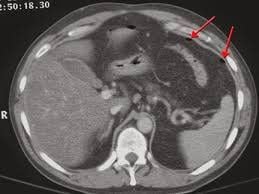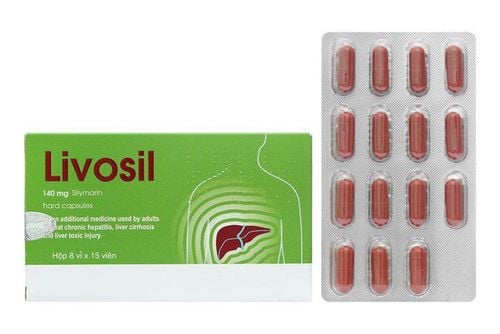This is an automatically translated article.
The article is professionally consulted by Master, Doctor Nguyen Van Phan - Radiologist - Department of Diagnostic Imaging and Nuclear Medicine - Vinmec Times City International General Hospital.Non-alcoholic fatty liver is now gradually becoming common in the community. This is considered the leading cause of hepatitis and elevated liver enzymes, accounting for about 25% in Asian countries. Nonalcoholic fatty liver disease can lead to complications such as cirrhosis and liver cancer if not treated early. The diagnosis of fatty liver usually relies on a combination of laboratory tests and imaging modalities.
1. What is non-alcoholic fatty liver disease?
Fatty liver is generally the accumulation of fatty tissue within the liver parenchyma, which can occur even in people who do not drink alcohol. Fatty liver is divided into two main groups, including non-alcoholic fatty liver and alcoholic fatty liver. Among them, nonalcoholic fatty liver was first reported in 1980, and so far there are many articles and studies talking about this disease. The disease is common in middle-aged people, between 40 and 60 years old. A small number of cases have also been reported in childhood. Women have higher rates of non-alcoholic fatty liver disease than men. Nonalcoholic fatty liver disease has a better prognosis than alcoholic fatty liver disease.Nonalcoholic fatty liver is seen in people who barely consume alcohol, with a characteristic accumulation of fatty tissue and fibrous tissue inside the liver. The exact cause of nonalcoholic fatty liver disease is still unknown. According to statistics, people who are overweight, obese, have diabetes, are insulin resistant have a higher rate of non-alcoholic fatty liver disease.
The pathogenesis of nonalcoholic fatty liver disease has not been agreed. Today, insulin resistance is still considered the main mechanism of disease. Some authors argue that non-alcoholic fatty liver injury can be considered as one of the manifestations of systemic insulin resistance. Resistance to the action of the hormone insulin promotes the accumulation of fatty tissue in the liver, increasing the sensitivity to inflammatory agents. Therefore, inflammatory reactions associated with fatty liver are often noted.
People with nonalcoholic fatty liver disease do not have obvious clinical symptoms. Liver biopsy is the gold standard for diagnosis. The characteristic histopathological feature is the infiltration of adipocytes and fibroblasts into healthy liver tissue.
Nonalcoholic fatty liver disease has a slow and steady progression. The mortality rate was lower than in the alcoholic fatty liver disease group. However, more than 20% of patients with nonalcoholic fatty liver disease progress to cirrhosis.

2. What are the clinical manifestations of non-alcoholic fatty liver?
Most people with nonalcoholic fatty liver disease alone do not have obvious clinical manifestations. Some patients have flu-like symptoms such as fatigue and loss of appetite. At a later stage, when the disease has complications of cirrhosis, clinical signs may be noted such as jaundice, yellow eyes, right upper quadrant pain, weight loss.People with nonalcoholic fatty liver disease have a higher risk of developing cirrhosis than other groups. The mortality rate from liver disease and the overall mortality rate increased higher than that of the control group. Some other studies in the world also show that liver cancer on the background of non-alcoholic fatty liver disease is on the rise, leading to an increase in the need for liver transplantation.
Early detection of nonalcoholic fatty liver disease is significant in preventing complications and slowing the progression of the disease. Some people, even if there are no abnormal clinical manifestations, should go to the doctor periodically to be screened for non-alcoholic fatty liver disease:
Overweight, obese people. People with persistently elevated liver enzymes have not found the cause. People with type 2 diabetes, regardless of whether liver enzymes are elevated or not. People diagnosed with metabolic syndrome. People with hyperlipidemia, dyslipidemia.

3. What techniques help diagnose non-alcoholic fatty liver?
Because clinical symptoms are not specific, the diagnosis of NAFLD is mainly based on laboratory tests and imaging methods.Bilan basic blood test needs to survey liver enzymes, bilirubin, blood sugar, and blood lipid bilan. The majority of patients with nonalcoholic fatty liver disease have elevated liver enzymes, but normal liver enzymes are not a factor to rule out the disease. Elevated liver enzymes are common abnormalities and are not usually associated with other abnormalities such as bilirubinemia. People with type 2 diabetes with elevated blood sugar or a group of people with dyslipidemia are also noted to have a higher risk of fatty liver disease.
Non-alcoholic fatty liver images are also recorded on imaging facilities. Abdominal ultrasound is the first technique, widely indicated because of its ease of implementation, low cost, non-invasiveness, and safety for patients. The liver infiltrated with adipose tissue is more hyperechoic than the healthy liver, but the specificity of ultrasound is not high. Liver ultrasound can also evaluate the biliary system and the vascular system of the liver. Computed tomography (CT scan) and magnetic resonance imaging (MRI) are also indicated to make the diagnosis of nonalcoholic fatty liver disease. Fat infiltration was clearly observed as nonspecific for detecting fibrous tissues.
Liver fibrosis is an independent predictor of outcome in nonalcoholic fatty liver disease. Fibrosis is associated with rates of progression to cirrhosis, liver cancer, and mortality from liver disease. Liver elastography ultrasound is the most effective means of assessing liver fibrosis at present. This is a safe, non-invasive, and highly specific technique. Liver elastography ultrasound needs to be repeated many times during disease monitoring, increasing the accuracy of diagnosis, helping to avoid liver biopsy in some cases.
Liver tissue biopsy is a diagnostic technique to identify nonalcoholic fatty liver. When imaging tests cannot distinguish between alcoholic fatty liver and non-alcoholic fatty liver, the treating doctor will order a liver biopsy. A sample of hepatocellular tissue at the suspected site was removed and histopathologically examined. Nonalcoholic fatty liver shows fatty and fibrous tissue infiltrating liver tissue. However, this is an invasive technique that requires experienced people to perform to ensure patient safety, so it is not always available in all medical facilities.

Vinmec International General Hospital is one of the medical facilities with a team of leading medical experts in the field of Liver - Gallbladder - Pancreas with the most modern equipment in the region. If you have a need for consultation and examination at Vinmec Health System Hospitals nationwide, please book an appointment on the website for service.
Please dial HOTLINE for more information or register for an appointment HERE. Download MyVinmec app to make appointments faster and to manage your bookings easily.














